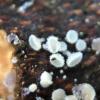
20-12-2025 23:08
Patrice TANCHAUDBonsoir, récolte sur sol sablonneux dans l'arri�

21-12-2025 09:32
Hello.A tiny ascomycete found embedded in wood in

20-12-2025 15:47
Mirek GrycHi.These grew on pine wood that was heavily covere

18-12-2025 21:17
Pol DebaenstThe identification took me to Byssonectria deformi

15-12-2025 07:09
 Danny Newman
Danny Newman
indet. Rutstroemiaceae sp. on unk. fallen leavesMc

19-12-2025 10:10
Patrice TANCHAUDBonjour, récolte réalisée en milieu dunaire, a

18-12-2025 17:23
 Bruno Coué
Bruno Coué
Bonjour,je serais heureux d'avoir votre avis sur c
Capitotricha from California
Alan Rockefeller,
03-07-2018 13:21
 I sequenced this little montane asco from a conifer stick that I expected to turn out to be Lachnum - However the ITS sequence came back and it appears to be a Capitotricha.
I sequenced this little montane asco from a conifer stick that I expected to turn out to be Lachnum - However the ITS sequence came back and it appears to be a Capitotricha.I just did a bit of microscopy on it. Macro and micro photos are available at https://mushroomobserver.org/317633.
The microscopy is all in Melzer's, and everything is inamyloid. Spores are very long and narrow.
ITS sequence: https://www.ncbi.nlm.nih.gov/nuccore/MH511099
Any thoughts on this?
Hans-Otto Baral,
03-07-2018 17:19

Re : Capitotricha from California
Hi Alan
very interesting case. The hair morphology is clearly that of a Capitotricha. Did you see any crystals on the hairs? Did you measure the spores? They look quite normal for the genus. I do not understand your statement of very long and narrow spores, are you sure you put the right ascus and spores photos?
A pity that you mounted oin MLZ!!! Important would be to check the ascus apex in Lugol for possible hemiamyloidity (or KOH-pretreated if you don't have Lugol) and the ascus base for croziers (in KOH and/or Congo Red).
Now, your sequence belongs to "Lachnellula" cervina, which in fact falls in Capitotricha. It is a species with 48-65 x 1.5 µm large spores on Betula branch (type, Dennis 1963: 338).
You get this result when testing the ITS in the CBS database:
http://www.westerdijkinstitute.nl/Collections/BioloMICSSequences.aspx
This is a find from USA Oregon, on Alnus rubra dead twig.
There is only 1 nt difference. This suggests that your sequence belongs to a fungus with very long, filiform spores.
But I must say I have a little doubt because C. bicolor on Alnus viridis (LT904858) is very close to it.
Zotto
very interesting case. The hair morphology is clearly that of a Capitotricha. Did you see any crystals on the hairs? Did you measure the spores? They look quite normal for the genus. I do not understand your statement of very long and narrow spores, are you sure you put the right ascus and spores photos?
A pity that you mounted oin MLZ!!! Important would be to check the ascus apex in Lugol for possible hemiamyloidity (or KOH-pretreated if you don't have Lugol) and the ascus base for croziers (in KOH and/or Congo Red).
Now, your sequence belongs to "Lachnellula" cervina, which in fact falls in Capitotricha. It is a species with 48-65 x 1.5 µm large spores on Betula branch (type, Dennis 1963: 338).
You get this result when testing the ITS in the CBS database:
http://www.westerdijkinstitute.nl/Collections/BioloMICSSequences.aspx
This is a find from USA Oregon, on Alnus rubra dead twig.
There is only 1 nt difference. This suggests that your sequence belongs to a fungus with very long, filiform spores.
But I must say I have a little doubt because C. bicolor on Alnus viridis (LT904858) is very close to it.
Zotto
Hans-Otto Baral,
07-07-2018 21:47

Re : Capitotricha from California
Hi Alan
I wonder if you could find out anything about this case.
Zotto
I wonder if you could find out anything about this case.
Zotto

